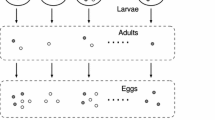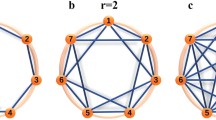Abstract
Hierarchical structured models for scramble and contest intraspecific competition are derived. The dynamical consequences of the two modes of competition are studied under the assumption that both populations divide up the same amount of a limiting resource at equal population levels. A comparison of equilibrium levels and their resiliences is made in order to determine which mode of competition is more advantageous. It is found that the concavity of the resource uptake rate is an important determining factor. Under certain circumstances contest competition is more advantageous for a population while under other circumstances scramble competition is more advantageous.
Similar content being viewed by others
References
Botsford, L. W., The effects of increased individual growth rates on depressed population size, Am. Nat. 117: 38–63 (1981)
Busenberg, S. and M. Iannelli, Separable models in age-dependent population dynamics, J. Math. Biol. 22: 145–173 (1985)
Costantino, R. F., and R. A. Desharnais, Population Dynamics and the Tribolium Model: Genetics and Demography, Monographs on Theoretical and Applied Genetics 13, Springer, Berlin, 1991
Cushing, J. M. and Jia Li, On Ebenman's model for the dynamics of a population with competing juveniles and adults, Bull. Math. Biol. 51: 687–713 (1989)
Cushing, J. M. and Jia Li, Juvenile versus adult competition, J. Math. Biol. 29: 457–473 (1991)
Cushing, J. M. and Jia Li, Intra-specific competition and density dependent juvenile growth, Bull. Math. Biol. 54(4): 503–519 (1992)
Cushing, J. M., A simple model of cannibalism, Math. Biosci. 107: 47–71 (1991)
Cushing, J. M., A size-structured model for cannibalism, Theor. Popul Biol. 42(3), 347–361 (1992)
Cushing, J. M., The dynamics of hierarchical age-structured populations, J. Math. Biol. 32: 705–729 (1994)
Cushing, J. M., Competition in hierarchically size-structured populations, to appear, Proceedings International Conference on Differential Equations & Applications to Biology and Industry, World Scientific Publ., Co., Singapore, 1995
Diekmann, O., R. M. Nisbet, W. S. C. Gurney and F. van den Bosch, Simple mathematical models for cannibalism: a critique and a new approach, Math. Biosci. 78: 21–46 (1986)
Ebenman, B., Niche differences between age classes and intra-specific competition in age-structured populations, J. Thor. Biol. 124: 25–33 (1987)
Ebenman, B., Competition between age classes and population dynamics, J. Theor. Biol. 131: 389–400 (1988)
Ebenman, B., Dynamics of age- and size-structured populations: intra-specific competition, Size-structured Populations (Ebenman & Persson eds.), Springer-Verlag, Berlin, 127–139, 1988
Ebenman, Bo and Lennart Persson, Size-structured Populations: Ecology and Evolution, Springer, Berlin, 1988
Gurtin, M. and R. C. MacCamy, Nonlinear age dependent population dynamics, Arch. Rat. Mech. Anal. 54: 281–300 (1974)
Gurtin, M. and R. C. MacCamy, Some simple models for nonlinear age-dependent population dynamics, Math. Biosci. 43: 199–211 (1979)
Hastings, A., Cycles in cannibalistic egg-larval interactions, J. Math. Biol. 24: 651–666 (1987)
Hastings, A. and R. F. Costantino, Cannibalistic egg-larva interactions in Tribolium: An explanation for the oscillations in population numbers, Am. Nat. 130: 36–52 (1987)
Hoppenstaedt, Frank, Mathematical Theories of Populations: Deomographics, Genetics and Epidemics, Reg. Conf. Series in Appl. Math., SIAM, Philadelphia, 1975
Landahl, H. D. and B. D. Hansen, A three stage population model with cannibalism, Bull. Math. Biol. 37: 11–17 (1975)
Lomnicki, A., Population Ecology of Individuals, Monographs in Population Biology 25, Princeton University Press, Princeton, New Jersey, 1988
Lomnicki, A. and J. Ombach: Resource partitioning within a single species population and population stability: a theoretical model, Theor. Pop. Biol. 25, 21–28 (1984)
Lomnicki, Adam and Stanislaw Sedziwy, Resource partitioning and population stability under exploitation competition, J. Theor. Biol. 132,: 119–120 (1988)
Loreau, M., Competition between age classes, and the stability of stage-structured populations: a re-examination of Ebenman's model, J. Theor. Biol. 144: 567–571 (1990)
Metz, J. A. J. and O. Diekmann, The Dynamics of Physiologically Structured Populations, Lecture Notes in Biomathematics 68, Springer, Berlin, Heidelberg, New York, 1986
Rogers, Alan R., Population dynamics under exploitation competition, J. Theor. Biol. 119: 363–368 (1986)
Stephen D. Simmes, Age dependent population dynamics with nonlinear interactions in the death rate, Ph.D. dissertation, Carnegie-Mellon University, 1978
Tschumy, W. O.: Competition between juveniles and adults in age-structured populations, Theor. Pop. Biol. 21: 255–268 (1982)
Tucker, S. L. and S. O. Zimmerman, A nonlinear model of population dynamics containing an arbitrary number of continuous structure variables, SIAM J. Appl. Math. 48(3), 549–591 (1988)
Webb, G. F. Theory of Nonlinear Age-Dependent Population Dynamics, Marcel Dekker, Inc., New York 1985
Werner, E. E. and J. F. Gilliam, The onogenetic niche and species interactions in size-structured populations, Ann. Rev. Ecol. Syst. 15, 393–425 (1984)
Van den Bosch, F., A. M. de Roos and W. Gabriel, Cannibalism as a life boat mechanism, J. Math. Biol. 26: 619–693 (1988)
Author information
Authors and Affiliations
Additional information
Supported by NSF grant DMS-9306271
Rights and permissions
About this article
Cite this article
Henson, S.M., Cushing, J.M. Hierarchical models of intra-specific competition: scramble versus contest. J. Math. Biol. 34, 755–772 (1996). https://doi.org/10.1007/BF00161518
Received:
Revised:
Issue Date:
DOI: https://doi.org/10.1007/BF00161518




